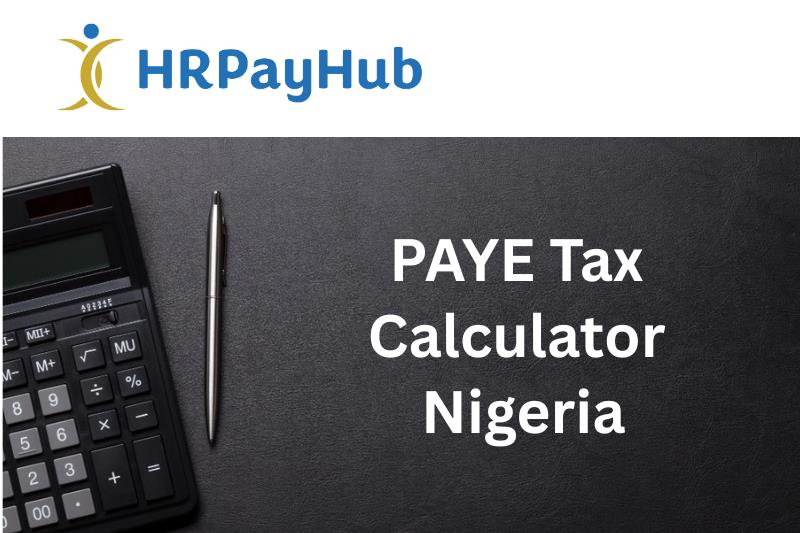
Understanding PAYE, pension, NHF, and NSITF deductions in Nigeria. Use HRPayHub’s free calculator to get accurate take-home pay
Whether you’re an HR manager preparing payroll, a finance lead validating remittances, or a professional trying to understand your payslip, Nigerian statutory deductions can feel confusing. Which deductions happen before tax? What happened after? What’s the difference between PAYE and NHF? And where does NSITF fit in if it doesn’t show on an employee’s net pay?
This guide breaks down the four pillars clearly; PAYE, Pension, NHF, and NSITF, and shows how to move from gross to net with confidence. We’ll also walk through how the free HRPayHub Tax Calculator models these items (with simple toggles), then finish with worked examples, error-proofing tips, and an FAQ you can share with your team.
Quick primer on statutory deductions (what each item really is)
Before we dive into calculations, anchor on the purpose of each deduction and whether it affects employee net pay or sits on the employer side.
1) PAYE (Pay-As-You-Earn): Employee tax, deducted monthly
What it is: Personal income tax deducted by the employer from the employee’s taxable income and remitted monthly to the relevant State Internal Revenue Service (e.g., LIRS in Lagos).
Why it matters: It is the single biggest driver of the difference between gross and net salary for most employees.
How it works conceptually:
- Start from gross pay (basic + allowances + bonuses).
- Subtract eligible pre-tax deductions (e.g., employee pension, NHF) to get taxable income.
- Apply reliefs/threshold rules and tax bands to calculate PAYE.
- Deduct PAYE (plus any post-tax items) to arrive at net pay.
Tip: PAYE is about order of operations. If you get the sequence wrong, your PAYE will be inaccurate. A calculator that enforces the sequence is your friend.
2) Pension (Contributory Pension Scheme) Split between employee and employer
What it is: Mandatory retirement savings where both the employee and employer contribute based on applicable rules.
Employee portion: Reduces taxable income because it’s taken before PAYE is calculated. It appears on the employee’s payslip as a deduction.
Employer portion: A company expense (not taken from the employee’s pay). It does not reduce the employee’s net, but you must track it for compliance and accounting.
Rule of thumb: On a payslip, you’ll see employee pension as a deduction. The employer pension belongs in the employer cost summary, not in the employee net.
3) NHF (National Housing Fund): Employee contribution, typically based on basic
What it is: A housing-focused employee contribution, commonly a small fixed percentage of basic salary (per current rules).
Tax position: Like employee pension, NHF is typically treated as a pre-tax item, reducing the taxable income used to compute PAYE.
Why it matters: Even small NHF amounts can shift PAYE when multiplied across a full year or a large headcount.
Sanity check: Ensure your HRIS/payroll labels NHF correctly and includes it in the pre-tax stage (not after PAYE).
4) NSITF (Nigeria Social Insurance Trust Fund): Employer cost
What it is: A social insurance contribution paid by the employer.
Payroll display: NSITF does not reduce employee net pay; it’s not deducted from the employee’s salary. It sits in employer payroll costs and remittances.
Compliance note: Although it’s not on the payslip net, you still need to calculate, accrue, and remit it accurately and keep evidence.
Quick summary table
| Item | Who pays? | Impacts employee Net Pay? | Stage |
|---|---|---|---|
| PAYE | Employee (withheld by employer) | Yes | After pre-tax deductions & reliefs |
| Pension (Employee) | Employee | Yes | Pre-tax (reduces taxable income) |
| Pension (Employer) | Employer | No | Employer cost only |
| NHF (Employee) | Employee | Yes | Pre-tax (reduces taxable income) |
| NSITF (Employer) | Employer | No | Employer cost only |
How HRPayHub computes each line item (with toggles)
The HRPayHub Free Nigeria Tax Calculator is built to mirror real-world payroll logic, so you can trust the order of operations and avoid math mistakes.
A. Clean inputs, clear structure
- Earnings: Enter basic salary, allowances (housing, transport, meal, shift, hardship, etc.), and bonus/commission when applicable.
- Profile selection: Choose Employee (PAYE route) or Contractor (used for comparison; contractors generally sit outside PAYE).
- Frequency: Work in monthly or annual terms; the calculator handles annualization.
B. Statutory toggles that actually change the math
- Pension (employee): Toggle ON/OFF to include the employee share as pre-tax.
- NHF (employee): Toggle ON/OFF to include as pre-tax.
- Other options: For payroll engine users, additional employer items (e.g., NSITF, employer pension) live in the employer cost view, not as employee deductions.
Why toggles matter: In reality, not all employees are enrolled in all schemes from day one (e.g., probation). The toggle approach lets you show exactly how the net changes with or without a given statutory.
C. Correct order of operations (the heart of accuracy)
- Gross Earnings
- Pre-tax deductions (employee pension, NHF, etc.) → Taxable Income
- Reliefs and tax bands → PAYE
- Post-tax deductions (e.g., loan, co-op, union dues)
- Net Pay (what hits the bank)
The calculator enforces this sequence automatically, so you don’t accidentally compute PAYE on the wrong base.
D. Instant breakdown + export
- Visual breakdown: Taxable income, PAYE, employee pension, NHF, net pay clearly labeled.
- Evidence: Save/download the breakdown for journals, approvals, and remittance support.
Multi-scenario views: Run variations (e.g., bonus month, joining mid-month, allowance tweaks) in seconds
Worked examples (junior, mid, senior roles)
Note: Numbers below are illustrative to show shape and sequence. Exact outcomes depend on your salary structure, reliefs, and the period’s rules. Use the free HRPayHub calculator to get your precise results.
Example 1: Junior role (steady monthly earnings)
Profile: Employee
Earnings: Basic ₦120,000; Housing ₦30,000; Transport ₦20,000
Pre-tax toggles: Pension (employee) ON; NHF ON
Post-tax items: None
Step-through logic:
- Gross = ₦120,000 + ₦30,000 + ₦20,000 = ₦170,000
- Pre-tax deductions (illustrative): Employee pension + NHF reduce the tax base
- Taxable income computed → apply reliefs/bands → PAYE calculated
- Net pay = Gross − Employee pension − NHF − PAYE
What this proves:
- Even modest employee pension/NHF contributions can lower PAYE meaningfully over a year.
- For entry roles, small configuration mistakes (e.g., treating NHF as post-tax) can create repeated payroll corrections and employee distrust.
Example 2: Mid-level role (bonus month + loan repayment)
Profile: Employee
Earnings: Basic ₦350,000; Housing ₦120,000; Transport ₦50,000; Bonus ₦200,000
Pre-tax toggles: Pension (employee) ON; NHF ON
Post-tax items: Loan repayment ₦30,000
Step-through logic:
- Gross increases due to bonus → raises taxable income this month
- Pre-tax deductions applied first → PAYE recalculated at higher tax base
- Post-tax loan repayment is deducted after PAYE
- Net pay reflects both higher PAYE (due to bonus) and the loan repayment
What this proves:
- Bonuses change the banding/reliefs interaction for the month.
- Keep repayments post-tax and clearly labeled so the employee sees why net dipped.
- Save the PDF breakdown—this reduces queries to HR/Finance.
Example 3: Senior role (allowance mix + contractor comparison)
Profile A (Employee): Basic ₦900,000; Housing ₦300,000; Transport ₦120,000; Other allowances ₦80,000
Pre-tax toggles: Pension (employee) ON; NHF ON
Post-tax items: None
Profile B (Contractor): Monthly invoice target equal to employee gross for comparison
Step-through logic:
- Employee view: Pre-tax items reduce taxable income; PAYE applies; net shows retirement saving + housing contribution impact.
- Contractor view: No PAYE payroll withholding here; contractor invoices the company (may face WHT and later personal tax obligations).
- Conversation outcome: The employee scenario shows structured retirement savings and employer costs (e.g., employer pension, NSITF) the contractor would need to self-fund. HRPayHub’s side-by-side view helps managers and candidates choose transparently.
What this proves:
- Senior compensation mixes multiple allowances; correct classification and pre-tax handling can shift take-home materially.
- Contractor comparisons require a total cost lens, not just invoice vs net salary.
Avoiding payroll errors: validations & audit trail (your “denial-proof” checklist)
Accuracy isn’t only about math; it’s also about controls. Here’s how HRPayHub helps you run clean payroll that’s ready for questions from employees, auditors, or regulators.
1) Required fields & format validation
- Hard checks on must-have inputs (basic, period, employee ID, state)
- Format guards (numbers only for amounts, date rules, etc.)
- Context hints (tooltips) so junior HR staff avoid guesswork
2) Pre-tax vs post-tax enforcement
- Employee pension and NHF treated as pre-tax when toggled ON
- Post-tax items (loan, co-op, union dues) come after PAYE, no accidental reordering
3) Rounding & proration logic
- Clean rounding to avoid extra kobo/naira drift
- Proration when someone joins/leaves mid-month, or during unpaid leave
4) Evidence panel & exports
- Breakdown PDF (Taxable Income → PAYE → Net Pay)
- Journal export for accounting, with branch/cost center mapping
- Remittance pack (schedules, receipts) stored alongside the run
5) Change logs & approvals
- Who changed what, when, and why (comment trails)
- Approval steps for sensitive changes (e.g., bonus uploads, back-dated edits)
Outcome: Fewer disputes, faster audits, and better month-end close. The same discipline that protects you during audits also improves employee trust—because you can show exactly how numbers were derived.
FAQs (reliefs, thresholds, common edge cases)
Q1: Which items reduce taxable income before PAYE?
A: Employee pension and NHF typically reduce taxable income before PAYE is calculated. Your employer contributions (pension, NSITF) are not taken from employee pay and should not appear as employee deductions.
Q2: Why is my PAYE higher in bonus months?
A: A bonus increases your gross for that month, so your taxable income rises and you may move through different tax bands. Using the calculator shows the exact effect—no surprises.
Q3: Does NSITF lower my take-home pay?
A: No. NSITF is an employer contribution. It affects employer cost, not employee net. Employees won’t see NSITF deducted from their payslips.
Q4: I toggled NHF on/off, and my net changed a lot—why?
A: Because NHF is treated as pre-tax, it lowers taxable income. Even small monthly changes can add up across a year, shifting PAYE and net pay.
Q5: Employee vs contractor: why does the contractor's “net” look higher?
A: Invoices can appear larger, but contractors don’t receive employer pension contributions or employer-borne items like NSITF. They must also handle personal tax planning and retirement savings independently. The calculator’s side-by-side helps you make an informed call.
Q6: How do I handle new joiners/leavers mid-month?
A: In HRPayHub payroll, proration rules apply automatically. For quick estimates in the free calculator, enter the prorated gross for the period.
Q7: What about annual returns and multi-state operations?
A: You still need to file employer annual returns and remit PAYE to the correct state authority. If you operate across states, align with your tax advisor and keep a clean audit trail for each remittance.
Q8: Can I rely only on a calculator instead of professional advice?
A: The calculator gives you accurate arithmetic and a transparent breakdown, but it doesn’t replace tax advice, especially for unusual structures, benefit plans, or multi-state scenarios.
“Tax calculator Nigeria” in action: shareable use-cases
- HR to Finance: “Here’s the PDF breakdown for our run, note pension/NHF pre-tax, these post-tax deductions, and the PAYE schedule attached.”
- Offer letters: “At this gross, estimated take-home is ₦X with pension/NHF—see calculator screenshot; final numbers in payroll.”
- Employee queries: “Your bonus increased taxable income this month; this PDF shows how PAYE changed and why your net is different.”
- Scenario planning: “Let’s see how adding a housing allowance changes net; toggle it on and compare.”
- Cost forecasting: “Contractor vs employee at the same gross—see the difference in remittances and employer costs.”
The bottom line: make payroll simple, consistent, and auditable
If you remember just three things, make them these:
- Sequence beats memory. Always compute pre-tax items first, then PAYE, then post-tax—let the tool enforce it.
- Labels matter. Keep employee vs employer contributions distinct (pension, NSITF).
- Evidence wins. Save breakdowns and remittance proofs; they end audit anxiety and reduce employee disputes.
When you’re ready to move beyond one-off calculations to a full payroll stack, bulk imports, grade rules, offer letters with e-signature, audit trails, and even pay-as-you-go filings, HRPayHub is built for that too.
Calculate your deductions—free, no signup.
Run your numbers now with the HRPayHub Free Nigeria Tax Calculator, view the full breakdown, and export evidence with a single click. When you’re ready, book a 20-minute demo to see payroll automation in action.

